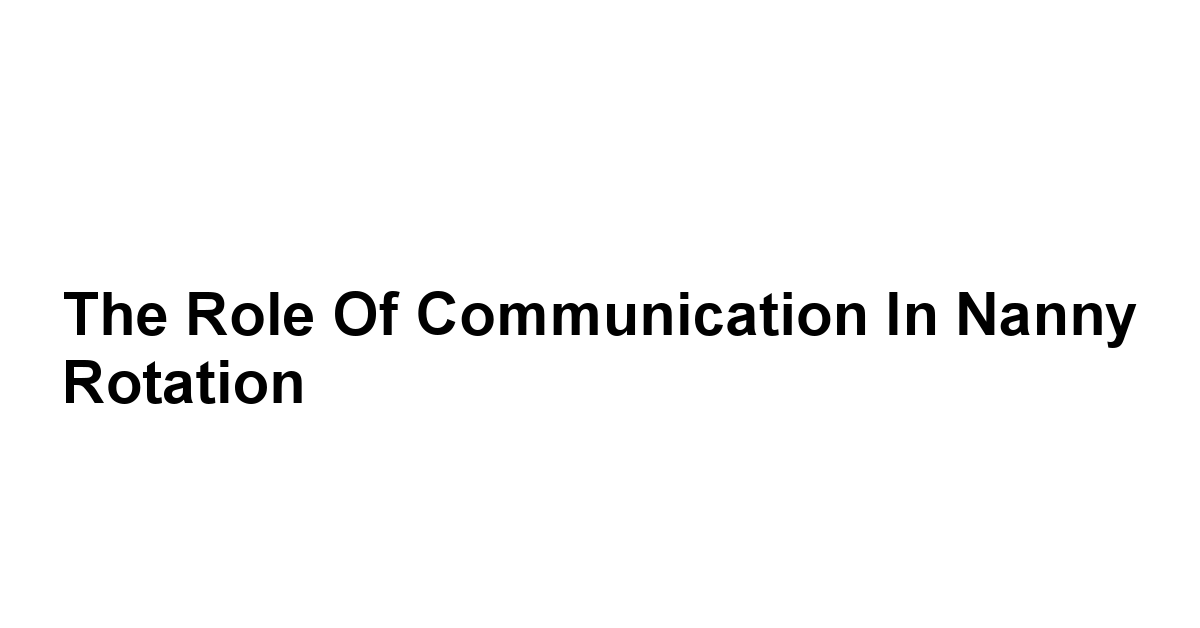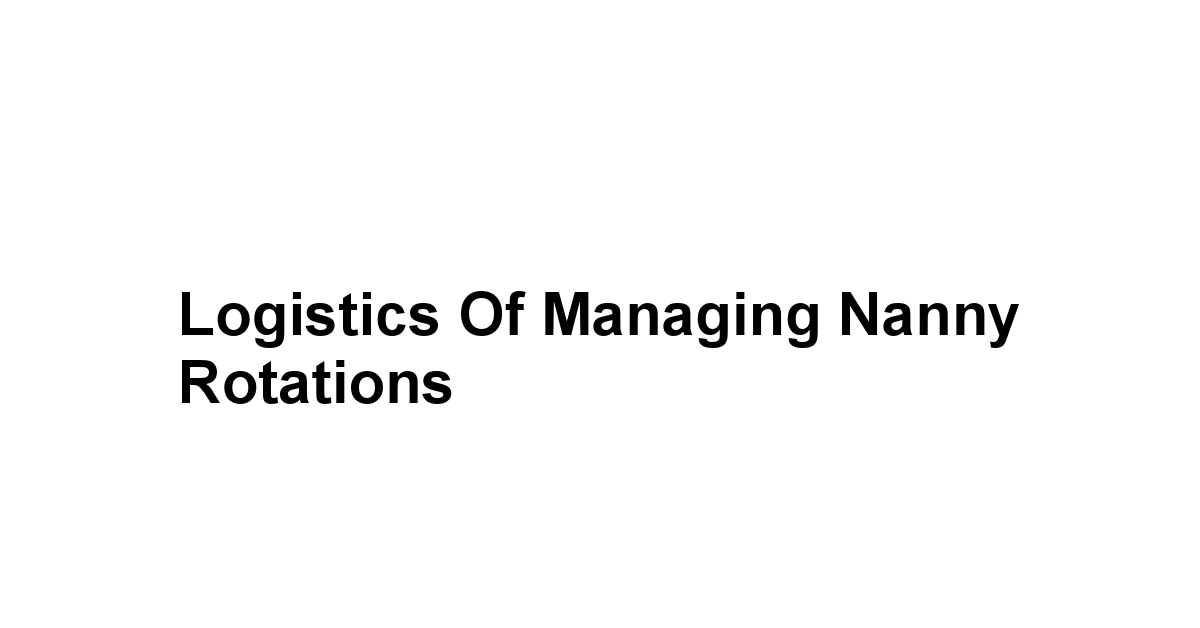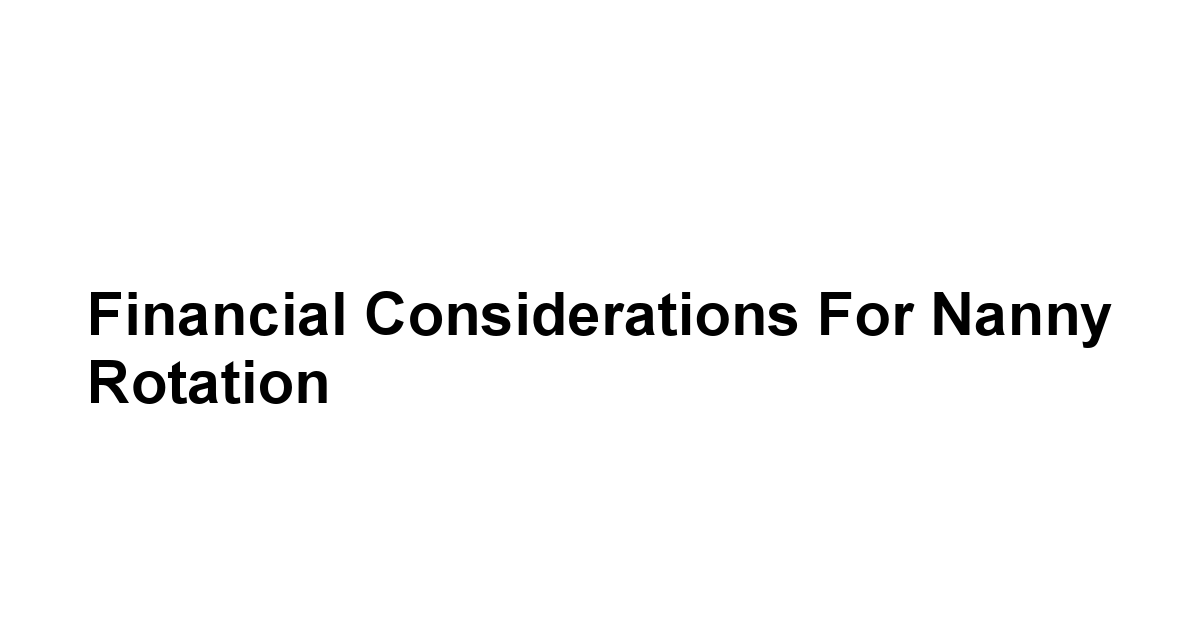Bespoke Nanny Rotation

Imagine, if you will, a world where bespoke nanny rotation turns your home into a circus of joy, a harmonious tent where your children grow wild and free, all while you sip coffee — perhaps with a splash of something stronger.
This clever twist on childcare brings together multiple caregivers, each with their own bag of tricks, crafting an enriching environment that feels as comfortable as an old shoe.
In a world where more than 70% of families with kids under 18 are leaning on outsiders for care, it’s about time we pick some methods that don’t just meet the kids’ needs but also keep the sanity meter in the green.
We’ll dive into the many, many benefits of this bespoke nanny rotation.
Think of it like a jazz band, each podcastian contributing their own flair — art, social savvy, brainy books — the whole tune comes together to elevate your children’s minds and souls.
Plus, we’ll see how this rotation lightens the load for your nannies, keeping their spirits high and their coffee mugs full.
Now, let’s consider the perks, shall we?
- Enhanced Learning: A child who sings under an art-loving nanny might just paint the sky, while another, learning with a math whiz, could be plotting to take over the universe.
- Support for Caregivers: When nannies share the stage, they get to recharge their batteries. A rested nanny equals a superhero for your little ones.
- Adaptive Scheduling: You can shuffle caregivers like a deck of cards, sliding them in and out as life throws its curveballs. Flexibility, my friend, is the name of the game.
- Social Growth: Kids who meet different adults pick up varied skills. They learn the art of conversation, and maybe how to beg for snacks from anyone with a snack aisle.
How do you set this circus in motion? Start by figuring out your family’s needs.
How many little beasts do you have? Any special quirks they come with? From infants needing a steady hand to teens thirsting for wisdom, knowing your crew helps pave the way.
Next up, gather the talent.
Check out nannies’ qualifications and personalities. Make sure they fit your family vibe like a glove.
Draw up a schedule that includes each caregiver, mixing consistency with a dash of flexibility.
Communication is your golden ticket.
Lay down what you expect early on with clear roles, rules, and a game plan for emergencies.
Promote a feedback culture so everyone — parents, children, and nannies alike — gets to chip in their two cents.
As your bespoke nanny rotation starts dancing to its own rhythm, think about investing in ongoing training.
Create an atmosphere where everyone keeps improving — happy nannies lead to even happier children.
In the end, a bespoke nanny rotation isn’t just a shiny strategy, it’s a thriving ecosystem built on growth, flexibility, and respect.
Embrace it, and watch your family flourish while you securely hold the circus ringleader’s hat.

Bespoke nanny rotation is a tailored approach to childcare that acknowledges the unique needs of each family.
It’s not just about hiring nannies, it’s about creating a harmonious environment in which children can thrive.
In this setup, several nannies share responsibilities, rotating according to a pre-defined schedule that best suits the family dynamic.
This method ensures a variety of caregiver interactions, which can significantly enhance the emotional and social development of children.
The concept goes beyond merely filling shifts.
Bespoke nanny rotation is built on an understanding that different caregivers bring various strengths and approaches to childcare.
A carefully curated team provides a balance, ensuring that each child receives the attention and care they need from nurturing adults who can adapt to their individual personalities.
This strategy also alleviates the strain on any single nanny, ultimately fostering a more sustainable and effective caregiving arrangement.
In the stormy sea of family life, there’s often a moment when you just need a hand to hold or a voice to guide you. Enter the 24-hour family support line. It’s like having a life raft in turbulent waters.
Trained counselors stand ready, all day and night, to lend an ear and a bit of wisdom—because when the chips are down, who doesn’t need a little help? Almost 40% of families hit a rough patch each year.
Mental health hiccups, wallet woes, or the delightful chaos of raising kids can strike at any hour.

A bespoke nanny rotation system integrates multiple caregivers into one cohesive caregiving strategy.
Each nanny plays a vital role, bringing their skills and personalities into the mix.
Parents are no longer confined to a single caregiver, but rather can embrace a collaborative environment where children experience the benefits of diverse interactions.
The setup often involves a rotating schedule, managed by the family or an agency specializing in creating bespoke solutions.
Nannies may work different days or shifts, ensuring that the children always have familiar faces around while also benefiting from new interactions regularly.
As a result, children learn adaptability and social skills from their varied contacts.
Key Benefits of Nanny Rotation
- Diverse Skill Sets:
Having a range of nannies means children benefit from diverse experiences.
For instance, one nanny might specialize in art, while another focuses on academic tutoring.
This variety enhances children’s learning and emotional growth.
- Reduced Burnout for Caregivers:
Caregiving can be demanding, leading to burnout if a single nanny is responsible for all shifts.
Rotation allows caregivers time off, leading to increased energy and enthusiasm when they return.
- Consistent Care Quality:
With multiple caregivers involved, the quality of care can be consistently high.
Each nanny can step in during their shift, ensuring that the transition between caregivers is smooth and seamless.
- Flexibility:
Families can adjust the schedule according to changing circumstances.
Whether parents’ work demands shift, or children need different levels of care while growing up, a bespoke system adapts easily.
- Enhanced Social Skills for Children:
Regularly interacting with different caregivers helps children learn how to build relationships and socialize with various leadership styles, allowing them to become more well-rounded individuals.
Who Can Benefit from This Service?
Bespoke nanny rotation can be advantageous for a wide array of families.
Busy professionals who work irregular hours or have demanding jobs often find that having a team of caregivers allows them the flexibility they require.
Families with multiple children benefit as well—different nannies can provide specialized attention to children of different ages and needs.
Moreover, families in transitional situations, such as those undergoing major life changes, can leverage a bespoke system to provide emotional stability during difficult times.
Furthermore, children with special needs can greatly benefit from caregivers with specialized training, ensuring they receive the highest level of care suited to their requirements.

Creating a bespoke nanny rotation requires thoughtful planning and a detailed understanding of your family’s unique needs.
It’s not merely about arranging schedules, it involves a comprehensive assessment of what styles of care will best suit your children and your family lifestyle.
Identifying the needs of your family begins with an exploration of your children’s ages, personalities, and interests.
For instance, toddlers may need constant engagement and supervision, while older children might require guidance with specific hobbies or academic assistance.
This assessment forms the foundation of an effective rotation strategy, helping you align specific nannies with the skills and temperament to match your children.
Assessing Your Family's Needs
Begin with a thorough evaluation of your family’s childcare demands. Consider the following key aspects:
- Age and Number of Children:
Document the ages of your children.
Younger children might need more physical and emotional support, while adolescents could benefit from mentoring. Here’s a quick age-specific need assessment:
- Infants: Frequent nurturing and care
- Toddlers: Playful engagement and safe exploration
- School-age Children: Academic guidance and socialization
- Teenagers: Independence and mentorship
- Family Schedules:
Align the availability of nannies with your family routine.
Parents working from home may need a different setup compared to parents with conventional working hours.
Use a scheduling tool that outlines who is available when.
- Individual Needs of Children:
Analyze if any child requires special attention or specific expertise.
For instance, if one child has learning difficulties, look for caregivers who have experience in educational methods suited for children with similar needs.
- Cultural or Language Considerations:
If there are specific linguistic or cultural preferences within your family, ensure that those factors are integrated into your rotation design as well.
This can enrich the child’s learning and personal growth.
Choosing the Right Nannies
Selecting the right nannies is crucial to the success of a bespoke nanny rotation.
Not only should they be qualified, but they also need to have the right temperament. Here are important criteria to consider:
- Qualifications and Experience:
Look for caregivers with experience in managing various ages.
Familiarity with developmental milestones is paramount.
Also, certificates in CPR, first aid, and educational backgrounds in child psychology can be useful.
- Personality Fit:
Schedule interviews and engage the candidates in activities with your children. Note how they interact with your kids.
Are they engaging, patient, and enthusiastic? Having a personality match will create a better connection.
- Background Checks:
Conduct thorough background checks, including references, to verify their professional experience and personal history. - Training in Special Needs:
If you have children with specific questions or difficulties, look for nannies with specialized training in those areas. - Trial Period:
Consider a trial period with the selected nannies.
This allows the family and nannies to assess if the arrangement works.
It’s particularly important to evaluate how the children respond during this period.
Creating a Custom Schedule
Once the family needs are assessed and nannies selected, creating a tailored schedule is essential.
Here are steps to build an efficient rotation plan:
- Charting the Week:
Use a digital calendar or childcare management app to visualize the rotation.
Include available shifts for each nanny and align this with family activities, school hours, and extracurricular commitments.
- Balance Shifts:
Aim for equitable distribution of hours among nannies to avoid overworking specific individuals.
Of note is to ensure coverage during peak times, like evenings and weekends.
- Rotation Frequency:
Determine how frequently nannies will rotate.
Options may include weekly, bi-weekly, or even monthly rotations.
Be aware of how frequently your children may need adjustments to new caregivers.
- Stay Flexible:
Life can throw curveballs.
Having a structure is great, but be prepared to adjust the schedule as needed.
Use a group chat among nannies for real-time updates to maintain clear communication about availability and shifts.
- Feedback and Iteration:
Encourage feedback from nannies and children regarding the schedule.
Small adjustments can significantly enhance the flow.
Regular check-in sessions can assist you in making informed decisions.

Communication serves as the backbone of any successful bespoke nanny rotation.
It ensures that every aspect of the children’s care is aligned and consistent, fostering a collaborative environment among caregivers and parents alike.
Clear channels of communication reduce misunderstandings, enhance flexibility, and ultimately lead to improved outcomes for the children.
Establishing proper communication routines minimizes the chaos of managing multiple caregivers.
Regular check-ins and updates provide a holistic view of a child’s progress, making it easier to identify areas that need attention or adaptation.
Establishing Clear Expectations
Setting expectations upfront is crucial before beginning a rotation. Here are significant elements to communicate:
- Daily Responsibilities:
Clearly outline the daily tasks expected of each nanny, including:- Child supervision and playtime
- Meal preparation and snack times
- Educational activities and learning objectives
- Behavioral Guidelines:
Share your family’s behavioral expectations and disciplinary methods.
Nannies should be aligned with your parenting approach to maintain consistency.
- Emergency Protocols:
Communicate how to handle emergencies, including health issues, behavioral issues, or unexpected events.
Ensure that every nanny understands who to contact in different situations.
- Open-Minded Collaboration:
Foster a culture of collaboration, encourage nannies to share observations or suggestions.
Each nanny brings a unique perspective that can enrich the caregiving environment.
Encouraging Feedback Between Nannies and Parents
Creating a feedback loop is essential for refining the care process.
Both parents and nannies should feel comfortable expressing their thoughts. Here’s how to foster this environment:
- Regular Meetings:
Schedule regular family meetings with the nannies for updates and sharing feedback about the children’s well-being and development.
Make these meetings casual to encourage open dialogue.
- Use of Technology:
Consider using apps designed for parent-caregiver communication.
These can help track daily activities and share important information in real-time.
- Joint Reflection Sessions:
Set aside time periodically for nannies and parents to discuss what is working and what isn’t.
This can lead to constructive changes in methods or interactions.
- Anonymous Feedback Options:
Implement an anonymous feedback tool that nannies can utilize if they feel uncomfortable speaking up publicly.
This can significantly enhance comfort and honesty.
Keeping Open Lines of Communication
It’s vital to maintain a continuous dialogue around everything from schedules to changes in the children’s behavior. Tips for ensuring open communication include:
- Frequent Check-ins:
Make it a habit to touch base at the start and end of each shift.
Brief conversations help in conveying daily plans and any changes that might occur.
- Monthly Reviews:
Establish monthly reviews regarding the children’s progress, which should include observations on each child’s emotional and academic development. - Communication Tools:
Utilize messaging tools or platforms like Trello and WhatsApp to facilitate updates.
Create specific channels or groups for different purposes i.e., emergency alerts, daily check-ins.
- Empower Separate Conversations:
Encourage nannies to engage with each other separately.
They can build rapport and stronger teamwork, further benefitting the children through shared experiences.

Investing in the training and support of your nannies establishes a foundation of excellence in caregiving.
Well-trained nannies display confidence in their roles and truly understand the nuances of childcare, leading to better emotional outcomes for children.
Ongoing training not only ensures up-to-date skills but also fosters commitment among caregivers.
When investing in their professional development, nannies are likely to be more dedicated and engaged within their roles.
Importance of Ongoing Training
- Skill Development:
Continual training helps nannies enhance their capabilities, which individuals can impart to children. Areas to focus on include:- First Aid and CPR
- Child development theories
- Conflict resolution and behavioral management strategies
- Staying Current:
Trends in childcare methods evolve.
Regular training ensures that staff are aware of new research and developments in the field that could be advantageous.
- Building a Community of Practice:
Provide opportunities for nannies to connect with one another through workshops or networks.
This interaction encourages sharing experiences, which can lead to collaborative improvement.
Workshops and Educational Opportunities
Invest in workshops tailored to childcare improvement.
Here are some potential workshop topics for nannies:
- Child Behavioral Management:
Focus on positive reinforcement and effective discipline strategies that nurture positive behavior. - Nutrition and Meal Planning:
Teach valuable skills in preparing balanced and healthy meals based on children’s dietary needs. - Creating Engaging Activities:
Workshops can help nannies design stimulating and educational activities that reflect developmental milestones. - Cultural Sensitivity Training:
Emphasize the importance of understanding diverse backgrounds to foster an inclusive atmosphere for the children.
Support Networks for Nannies
Develop a support network that includes both professional and emotional support for nannies.
This network can facilitate knowledge sharing and resource availability. Consider the following strategies:
- Regular Meetups:
Host informal gatherings where nannies can share experiences and learn from one another’s challenges. - Professional Counseling:
Offer access to counseling services to help nannies manage personal challenges that might affect their performance in caregiving. - Resource Sharing:
Create a repository of resources, such as articles, books, and online courses related to child development and education. - Incentives for Participation:
Encourage nannies to participate in training and workshops by offering incentives, such as bonuses or time off.

Managing rotations requires planning.
The logistics of scheduling, communication, and performance tracking needs a systematic approach.
Families benefit when caregivers are well-managed, improving the overall efficiency of child care delivery.
An ideal nanny rotation should facilitate smooth transitions between caregivers while ensuring children are comfortable and secure with every nanny.
Addressing logistics proactively enables families to pivot gracefully amidst changes.
Scheduling and Time Management
Effective scheduling is the cornerstone of a successful nanny rotation system. Time management strategies include:
- Digital Calendars:
Utilize shared calendars like Google Calendar where all nannies can input availability, allowing for transparent scheduling among parties. - Shift Planning Templates:
Create templates or use software solutions designed for workforce management.
This enables parents to easily view the schedules and modifications.
- Time Off Policies:
Implement fair policies for time off requests.
Analyze how to cover shifts appropriately without undue stress on other nannies.
- Monitoring Attendance:
Track attendance closely to understand any recurrent issues or patterns that could signal a need for adjustment or support.
Dealing with Emergencies and Last-Minute Changes
While planning can alleviate most issues, emergencies and unexpected changes will occur. A few strategies to handle these are:
- Emergency Protocols:
Have clear protocols in place regarding who to contact in case of emergencies, ensuring that all nannies are equipped to respond appropriately. - Backup Plans:
Maintain a list of backup nannies who can step in at short notice.
Having pre-approvals from potential backup caregivers strengthens this system.
- Real-Time Communication Channels:
Establish communication channels for urgent messages.
Apps like Slack or GroupMe facilitate quick exchanges of information for urgent needs.
Tracking Nanny Performance and Satisfaction
Regularly appraise nanny performance.
Establishing metrics for performance allows families to gauge how well caregivers meet expectations. Consider these methods:
- Performance Reviews:
Conduct regular performance evaluations based on pre-determined criteria.
Include observations from parents and self-assessments from nannies.
- Satisfaction Surveys:
Develop surveys for both parents and nannies to capture feedback on the environment, interactions, and overall satisfaction of the arrangement. - Setting Goals:
Work collaboratively with nannies to set developmental goals that can enhance their skills and caregiving efforts. - Adapt and Adjust:
Be willing to adapt the rotation based on feedback and performance assessments.
Switching nannies based on strengths, engagements, and experiences can provide fresh energy into the environment.

Investing in a bespoke nanny rotation can appear financially daunting, but the benefits justify the costs when structured effectively.
Understanding the costs involved, budgeting wisely, and exploring financial assistance options can significantly ease the burden.
Education around financial aspects can lead to more informed decisions regarding childcare.
Being educated allows parents to strategize better and align their financial plans with their needs.
Understanding Costs and Budgeting
It is essential to have a clear grasp of the potential costs associated with employing multiple nannies. Costs can fluctuate based on various factors:
- Nanny Salaries:
According to the International Nanny Association, the average hourly wage for nannies varies widely based on locale, with many metropolitan areas seeing rates between $15 to $30 an hour. - Payroll Burden:
Consider taxes and additional benefits like health insurance or paid time off as far as hiring multiple nannies goes. Prepare a budget that accounts for these expenses. - Training and Development Costs:
Allocate funds for ongoing training and workshops, which contribute to the overall quality of care provided. - Management Fees if applicable:
If you’re utilizing an agency to help manage the nanny rotation, remember to account for management fees in your budget.
The Value of Investing in Quality Care
The effects of investing in quality childcare are profound.
Research consistently indicates that higher-quality caregiving correlates with better developmental outcomes.
- Child Development Studies: Studies indicate that children enrolled in high-quality care environments perform better socially and academically. For example, a 2018 study found that children with access to quality caregivers scored significantly higher in emotional wellbeing assessments.
- Long-term Financial Benefits: Investing in quality childcare can lead to more productive and potentially higher-earning individuals in society. Better education and social behavior often lead to optimized career opportunities in adulthood.
Exploring Options for Financial Assistance
Families may explore various financial assistance options to help ease the burden of childcare costs:
- Flexible Spending Accounts FSAs:
If available, these accounts allow parents to use pre-tax dollars to pay for childcare expenses. - Dependent Care Tax Credits:
Investigate federal tax credits available for dependent care expenses. These can result in valuable tax deductions. - Employer Childcare Benefits:
Some employers offer childcare benefits or stipends.
Inquire with human resources about available options.
- Local Subsidies and Grants:
Research local family assistance programs that might provide funding for childcare needs based on income levels.

Fostering a positive relationship with your nannies transcends mere employment, it creates a nurturing environment in which everyone thrives.
A respectful partnership benefits the children, caregivers, and families equally.
Taking time to appreciate nannies’ contributions fosters loyalty and commitment.
When caregivers feel respected and valued, they are more likely to create a positive, thriving atmosphere for the children.
Cultivating Trust and Mutual Respect
Trust forms the foundation of a functional relationship with nannies. To instill trust, consider these steps:
- Transparency:
Be open about expectations and family needs.
This transparency helps caregivers feel secure and valued.
- Recognition:
Regularly show appreciation for the work nannies do.
Simple gestures, such as thank-you notes or verbal recognition, can go a long way.
- Honesty in Communication:
Keep lines of communication open.
Offer constructive feedback regarding performance while also being receptive to their suggestions.
Celebrating Nanny Contributions
Recognizing the efforts of your nannies solidifies their value in your family dynamic. Here are ways to celebrate their contributions:
- Monthly Appreciation Days:
Dedicate a day each month to celebrate your nannies.
Simple gestures like giving small gifts or treats can make a difference.
- Personal Notes:
Craft personalized notes highlighting specific instances where their actions positively impacted your children. - Feedback Recognition:
During feedback sessions, highlight the successes and improvements facilitated by their contributions.
Create an environment where achievements are celebrated.
Encouraging Professional Development
Investing in the professional growth of nannies not only improves the quality of care but also demonstrates commitment to their career development. Best practices include:
- Support Education Goals:
Encourage nannies to pursue continued education in child development or first aid certifications. This investment benefits everyone in the long run. - Provide Resources:
Share resources such as books, articles, or online courses related to child care that can help nannies grow professionally. - Create Growth Paths:
Discuss career aspirations with nannies and collaboratively establish a path for achieving their professional development goals within your family setting.
Final Verdict
In conclusion, bespoke nanny rotation represents a revolution in how families approach childcare, catering to the unique needs and dynamics of individual households.
This system allows children to benefit from diverse interactions, which fosters adaptability and social skills, while simultaneously alleviating potential burnout amongst caregivers.
Recent studies have shown that variability in caregiver interactions can significantly enhance children’s emotional and social development, reducing stress in the caregiving environment and ensuring consistent quality of care.
The thoughtful design of this system not only enhances the day-to-day lives of families but also contributes to the long-term emotional and developmental success of children.
The advantages of a bespoke nanny rotation are manifold, including the provision of diverse skill sets tailored to meet the varied needs of children across different ages and stages of development.
Caregivers bring their unique strengths, enabling children to engage with various perspectives and skills—be it in arts, academics, or lifestyle activities.
Moreover, this rotation model promotes better relationships, not just between nannies and children, but also among nannies themselves, fostering a collaborative environment that is essential for successful childcare practices.
Strong relationships built on trust and communication create a nurturing atmosphere where children can thrive.
Implementing a bespoke nanny rotation also demands a commitment from parents to invest time and resources into selecting the right caregivers and establishing effective communication channels.
By conducting thorough assessments of family dynamics and individual child needs, parents can ensure that nannies are not only qualified but also a good fit for their family’s unique environment.
Regular training, feedback loops, and performance evaluations contribute to an atmosphere where caregivers feel valued and can grow in their roles, thus enriching the childcare experience for children within this framework.
Finally, the positive outcomes of a bespoke nanny rotation extend beyond immediate childcare benefits.
The long-term societal implications, including better social, educational, and emotional outcomes for children, reaffirm the importance of investing in quality caregiving.
The bespoke nanny rotation is not merely a caregiving arrangement, it’s a step toward fostering enriched lives and stronger communities.
Frequently Asked Questions
What exactly is a bespoke nanny rotation?
A bespoke nanny rotation is a childcare model where multiple nannies take turns caring for children according to a flexible schedule. This approach caters to each child’s unique needs, fostering development through diverse interactions.
How does a rotating schedule benefit children?
A rotating schedule introduces children to various caregivers, enhancing their adaptability and social skills. Regular interaction with different nannies allows for richer experiences and nurtures their overall development.
Who can benefit from a bespoke nanny rotation?
Busy families, those with multiple children, or anyone going through significant life changes can greatly benefit. This model allows tailored care specific to each child’s age, needs, and strengths, helping them thrive within a supportive environment.
How do I choose the right nannies for the rotation?
Selecting nannies involves assessing their qualifications, personality fit, and suitability for your children’s needs. It’s valuable to conduct interviews, check references, and observe interactions with your kids to ensure a good match.
What should I consider when designing a bespoke nanny rotation?
Begin by evaluating your family’s needs, including the ages and individual requirements of your children. Next, establish availability and personal considerations for nannies. Align caregivers’ skills with your children’s personalities to create a strong rotation.
How can I ensure effective communication among caregivers?
Setting up clear communication channels is essential. Regular check-ins, utilizing communication apps, and holding family meetings with nannies help reduce misunderstandings and keep everyone informed about the children’s well-being.
What kind of training should I consider for nannies?
Investing in ongoing training is crucial. Focus on areas such as child development, first aid, and effective communication strategies. Workshops can also enhance their skills and encourage a sense of community among caregivers.
How do I manage the logistics of a nanny rotation?
Use digital tools for scheduling, set clear time-off policies, and establish a protocol for emergencies. Transparent management ensures smooth transitions between caregivers, keeping your childcare organized and efficient.
Are there financial considerations I should be aware of?
Understand the costs involved in hiring multiple nannies, including salaries, training, and potential management fees. Create a budget that reflects these expenses, and look into financial assistance options available for childcare.
How can I build a positive relationship with my nannies?
Foster trust and mutual respect by being transparent about expectations and acknowledging their contributions regularly. Celebrating achievements and encouraging professional growth helps create a nurturing environment for both caregivers and children.